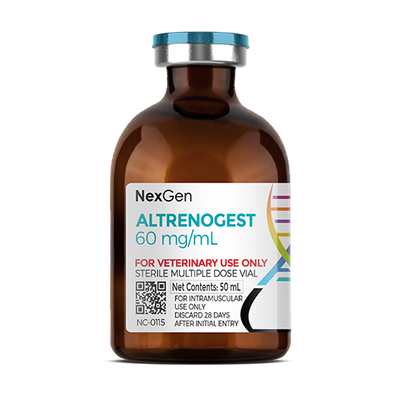
Medroxyprogesterone Acetate 200 mg/mL, Injectable, (30mL)
Login for pricing
- Brand
- Mixlab
- SKU:
- NC-0047
- Product Type:
- Injectable
- Size:
- 30ml
- Administration:
- Intramuscular
- Therapeutic Class:
- Hormone
Mare are seasonally polyestrus, which means they have an anovulatory period during the short light days of late fall and early winter, and begin to ovulate as the days become longer beginning in the spring. The sexual behavior of the mare probably evolved in the social context of family groups that typically consist of multiple adult mares and their young offspring, plus one or more adult stallions.1 Behavior that identifies mares as being estrous or non-estrous status has been grouped into three categories: attractivity, proceptivity, and receptivity.2
During the ovulatory season, the developing follicle releases estradiol (an estrogen), which brings on estrous (or “heat”) behaviors. Nature’s purpose for this dynamic is to facilitate the mare attracting a stallion. Unfortunately, these behaviors—frequent urination, squealing, tail swishing, and threatening other horses—are the ones that hamper a mare’s trainability and performance. Estrogen also results in muscle relaxation, so it’s possible that subtle lameness issues become more uncomfortable for when muscular support is lacking, leaving the mare more at risk for soft-tissue strains. Mares can also become quite uncomfortable as follicles develop—to the point of presenting with full-blown colic symptoms during ovulation.1
Where to buy Medroxyprogesterone
Medroxyprogesterone is available in the U.S. through pharmaceutical manufacturers and through veterinary custom compounding companies.
Medroxyprogesterone carries several potential drug interactions. Please consult your veterinarian prior to beginning any treatment regimen.
FOR RX ONLY: A valid prescription from a licensed veterinarian is required for dispensing this medication.
1Crowell-Davis, S. Sexual behavior of mares. Hormones and Behavior 52 (2007) 12–17.
2Beach, F.A., 1976. Sexual attractivity, proceptivity and receptivity in female mammals. Horm. Behav. 7, 105–138.
4Dascanio J. Hormonal Control of Reproduction. Proceedings: ABVP 2009. 2009. Veterinary Information Network.




















